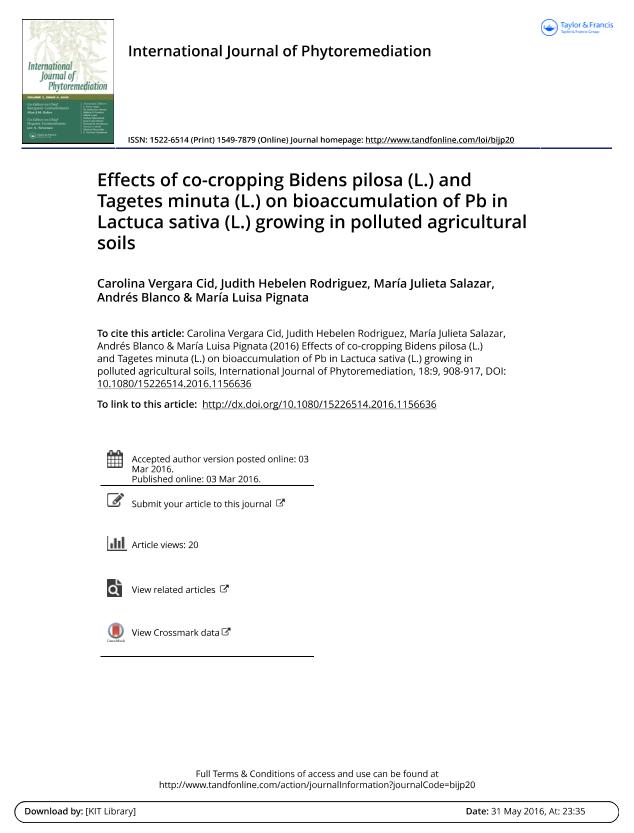Artículo
Effects of co-cropping Bidens pilosa (L.) and Tagetes minuta (L.) on bioaccumulation of Pb in lactuca sativa (L.) growing in polluted agricultural soils
Vergara Cid, Carolina ; Rodriguez, Judith Hebelen
; Rodriguez, Judith Hebelen ; Salazar, María Julieta
; Salazar, María Julieta ; Blanco, Andrés
; Blanco, Andrés ; Pignata, Maria Luisa
; Pignata, Maria Luisa
 ; Rodriguez, Judith Hebelen
; Rodriguez, Judith Hebelen ; Salazar, María Julieta
; Salazar, María Julieta ; Blanco, Andrés
; Blanco, Andrés ; Pignata, Maria Luisa
; Pignata, Maria Luisa
Fecha de publicación:
03/2016
Editorial:
Taylor & Francis
Revista:
International Journal of Phytoremediation
ISSN:
1522-6514
e-ISSN:
1549-7879
Idioma:
Inglés
Tipo de recurso:
Artículo publicado
Clasificación temática:
Resumen
Polluted agricultural soils are a serious problem for food safety, with phytoremediation being the most favorable alternative from the environmental perspective. However, this methodology is generally timeconsuming and requires the cessation of agriculture. Therefore, the purpose of this study was to evaluate two potential phytoextractor plants (the native species Bidens pilosa and Tagetes minuta) co-cropped with lettuce growing on agricultural lead-polluted soils. The concentrations of Pb, as well as of other metals, were investigated in the phytoextractors, crop species, and in soils, with the potential risk to the health of consumers being estimated. The soil parameters pH, EC, organic matter percentage and bioavailable lead showed a direct relationship with the accumulation of Pb in roots. In addition, the concentration of Pb in roots of native species was closely related to Fe (B. pilosa, r D 0.81; T. minuta r D 0.75), Cu (T. minuta, r D 0.93), Mn (B. pilosa, r D 0.89) and Zn (B. pilosa, r D 0.91; T. minuta, r D 0.91). Our results indicate that the interaction between rhizospheres increased the phytoextraction of lead, which was accompanied by an increase in the biomass of the phytoextractor species. However, the consumption of lettuce still revealed a toxicological risk from Pb in all treatments.
Palabras clave:
B. Pilosa
,
Co-Cropping Phytoremediation
,
Food Safety
,
Lactuca Sativa
,
T. Minuta
Archivos asociados
Licencia
Identificadores
Colecciones
Articulos(IMBIV)
Articulos de INST.MULTIDISCIPL.DE BIOLOGIA VEGETAL (P)
Articulos de INST.MULTIDISCIPL.DE BIOLOGIA VEGETAL (P)
Citación
Vergara Cid, Carolina; Rodriguez, Judith Hebelen; Salazar, María Julieta; Blanco, Andrés; Pignata, Maria Luisa; Effects of co-cropping Bidens pilosa (L.) and Tagetes minuta (L.) on bioaccumulation of Pb in lactuca sativa (L.) growing in polluted agricultural soils; Taylor & Francis; International Journal of Phytoremediation; 18; 9; 3-2016; 908-917
Compartir
Altmétricas



